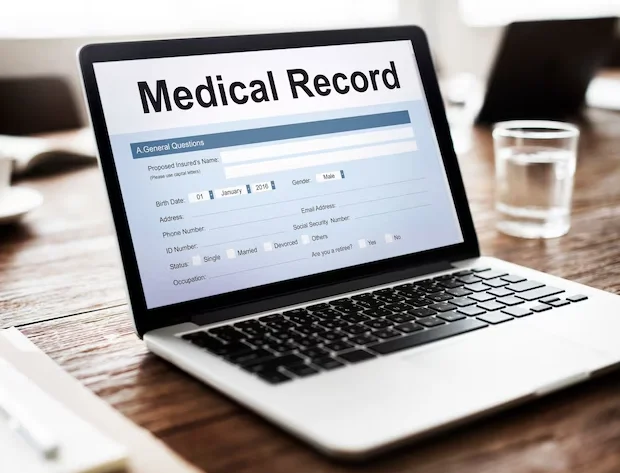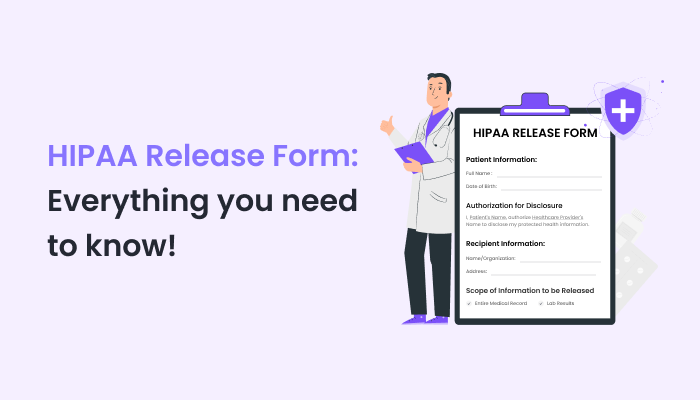HIPAA Release Form: Everything you need to know!
As a patient or healthcare provider, you must know all about the HIPAA Release Form.
Imagine walking into a hospital, confidently sharing your Protected Health Information (PHI) to receive the best care possible, knowing exactly who can access it. That’s the power of a HIPAA release form! Technically, it’s a signed document that ensures your PHI is shared securely and only for a specified purpose, giving you control over your medical information. It is a medical authorization form that ensures data safety.
HIPAA – The Health Insurance Portability and Accountability Act is a standard that safeguards patient information. The major part of these HIPAA rules is the HIPAA Release Form or HIPAA compliant forms, a very crucial document. It ensures that patient data is safely shared with others with clear consent of the patient.
Beyond patients, considering HIPAA compliance and understanding all about it is important for healthcare providers. This medical release form ensures credibility, and trust, and following HIPAA guidelines keeps you safe.
This article specifically deals with it all. You will get answers to What is the HIPAA authorization? And What is the purpose of the HIPAA form? Apart from that, you will get to know the essential elements to be included in this medical record release form. Let’s get going.

Do you remember those permission slips that your parents had to sign to allow you for school field trips? A HIPAA Release form is a similar document but for protected health information.
A signed document or a HIPAA-compliant form is technically a legal permission. This is permission from a patient to a healthcare provider. It allows healthcare providers to share a patient’s medical history and necessary information with a third party, ensuring seamless care coordination. The purpose must always be clearly defined, promoting transparency and trust.
It safeguards both patients and medical practitioners by ensuring that health information is shared responsibly and legally, reinforcing ethical medical practices. This ensures that a patient’s data is safe and is dealt with proper responsibility.
Let’s discuss the importance of HIPAA form to you as a healthcare provider in detail.

A form has to be user-friendly. In this case, it also must be legally sound. There should be no jargon or unclarity regarding the user input field. Let us look at all the aspects that a HIPAA release form should contain to ensure safety and compliance.
With these elements, your HIPAA form is a perfect tool to avoid any legalities and support your patients completely.
As an aware patient, you must check all the medical details and forms thoroughly. Instead of just signing thoughtlessly, check the details being asked of you. Further, make sure that the HIPAA release form is not clubbed with any other permission forms. From complying with legalities to building trust among patients, these forms are a game changer.
Ensure your time, energy, and money in caring for your patients. And use tools like ARForms to create HIPAA compliant forms. Trust me, with this process in check you will be very relieved about protected health information PHI.
Imagine walking into a hospital, confidently sharing your Protected Health Information (PHI) to receive the best care possible, knowing exactly who can access it. That’s the power of a HIPAA release form! Technically, it’s a signed document that ensures your PHI is shared securely and only for a specified purpose, giving you control over your medical information. It is a medical authorization form that ensures data safety.
HIPAA – The Health Insurance Portability and Accountability Act is a standard that safeguards patient information. The major part of these HIPAA rules is the HIPAA Release Form or HIPAA compliant forms, a very crucial document. It ensures that patient data is safely shared with others with clear consent of the patient.
Beyond patients, considering HIPAA compliance and understanding all about it is important for healthcare providers. This medical release form ensures credibility, and trust, and following HIPAA guidelines keeps you safe.
This article specifically deals with it all. You will get answers to What is the HIPAA authorization? And What is the purpose of the HIPAA form? Apart from that, you will get to know the essential elements to be included in this medical record release form. Let’s get going.
What is a HIPAA Release Form?

Do you remember those permission slips that your parents had to sign to allow you for school field trips? A HIPAA Release form is a similar document but for protected health information.
A signed document or a HIPAA-compliant form is technically a legal permission. This is permission from a patient to a healthcare provider. It allows healthcare providers to share a patient’s medical history and necessary information with a third party, ensuring seamless care coordination. The purpose must always be clearly defined, promoting transparency and trust.
But why is HIPAA privacy form so important?
It safeguards both patients and medical practitioners by ensuring that health information is shared responsibly and legally, reinforcing ethical medical practices. This ensures that a patient’s data is safe and is dealt with proper responsibility.
Common Scenarios Where HIPAA Release Forms Are Used
- To get a second opinion from another healthcare expert.
- To transfer the patient in the care of another specialist
- For medical updates to a caregiver, relatives, or other family member.
- To support legal cases wherein health information is involved.
- Processing insurance claims that need additional documentation.
Let’s discuss the importance of HIPAA form to you as a healthcare provider in detail.
Importance of Using a HIPAA Authorization Form for Healthcare Providers and Medical Practitioners
Let us explore a specific scenario. Your patient is switching doctors, and the new clinic reaches out for their medical history to ensure a smooth transition of care. With a properly signed HIPAA release form, you can confidently share the necessary details without any concerns, ensuring compliance and maintaining trust with your patients.1. Compliance with Federal Regulations
HIPAA rules and regulations are legal mandates, not just some basic forms. You ensure compliance using a medical record release form. This saves you from paying fine amounts like $50,000 per violation. By September 2024, awareness around HIPAA compliance had grown significantly, leading to 371,573 reported cases that helped refine and improve data protection practices across the healthcare industry. You as a medical practitioner must follow best practices to be safe.2. Trust Building with Patients
A doctor-patient relationship has to be transparent. For that, trust-building is important. A patient must know that their sensitive information will be kept safe and handled with care. Transparency fosters confidence and loyalty among patients that can be achieved by following HIPAA regulations thoroughly.3. Legal and Financial Safeguards
HIPAA compliance acts as a shield, protecting healthcare providers from prolonged legal and financial burdens while ensuring patient trust and security.4. Efficient Information Sharing
In emergencies, a pre-signed HIPAA form ensures patients receive immediate and uninterrupted care. This proactive approach allows doctors to focus on what truly matters—saving lives without the added concern of paperwork during critical moments. Thus, a pre-signed HIPAA certified form is essential where there is a possibility of third-party involvement and emergency decisions.Things to Include in a HIPAA Medical Records Request Form

A form has to be user-friendly. In this case, it also must be legally sound. There should be no jargon or unclarity regarding the user input field. Let us look at all the aspects that a HIPAA release form should contain to ensure safety and compliance.
1. Patient Identification
The patient’s name and other relevant details may seem like an obvious thing to add. But it’s good to have clarity. Include details like,- Patient’s Full Name
- Date of Birth
- Patient ID or Unique ID
- Contact Number
- Address
- 1st Date of Appointment/Visit/Treatment
2. Purpose of the Release
The purpose of releasing a patient’s medical information must be specified clearly. What can be the situations wherein you need to release patient’s protected health information?- Third-party requests like insurance companies or family members for further processing and decision-making.
- For using PHI for any marketing or fundraising activities.
- For sharing the details with a researcher or research foundation.
- On expiration or nullification of previous HIPAA release form.
- When the form has some inaccuracy or incomplete information, you need to create and process a new HIPAA release form.
- When the consent was previously taken with other permissions. A HIPAA release consent cannot be clubbed with other permissions. It must be explicit and separate.
3. Description of the Information to Be Released
Now, you might not need to share everything. Based on the purpose, mention the details that will be specifically shared. It can be lab results, medical history, diagnosis, or just billing details. Your patients should clearly know what will be shared. They must understand what they’re consenting to by filling the release form.4. Name of the Recipient
Clearly specify who will receive the PHI—whether it’s a specialist, a legal team, or an insurance agency. Including their legal name in the form ensures accountability and reinforces responsible data handling. This not only protects the patient’s privacy but also fosters trust between all involved parties.5. Expiration Date
A HIPAA release form comes with a defined time frame to ensure controlled and secure data access. Patients can specify this period in the form. For example, an OBGYN can share medical details with a doula throughout pregnancy and up to the child’s first year. For continued access beyond this period, a new HIPAA form is required, ensuring ongoing privacy protection.6. Patient Rights Acknowledgment
Just like GDPR compliance, for HIPAA compliance as well, a patient can revoke their permission to use data at any time. This ensures they have full control over their data.7. Signature and Date
A proper digital signature and date are essential to validate the form, ensuring both compliance and security. With HIPAA compliant form builder tools like ARForms, you can easily create forms that help capture digital signatures.With these elements, your HIPAA form is a perfect tool to avoid any legalities and support your patients completely.
How ARForms Can Help Maintain Healthcare Data Security
Using the right tools is important to create perfect HIPAA Release forms. Here’s how ARForms can be your perfect HIPAA compliant form builder tool.- ARForms helps secure data collection and storage. Its in-built spam protection ensures there are no fake entries.
- With ARForms, you get multiple customizable templates and sample forms to adapt to your needs.
- Add a digital signature input field for easy sign capturing. No hassle of printing and offline storing.
- Fully mobile-responsive to aid your patients completely. Thus, get the forms filled out instantly.
- ARForms integrates effortlessly with your workflow. You can add it to your website for patients to check before consulting.
Set Up Your Business with HIPAA Compliance
With the healthcare sector growing rapidly, ensuring data security has never been more important. By prioritizing HIPAA compliance, you build trust with patients, protect sensitive information, and create a secure environment for both medical professionals and the people they serve. The HIPAA release form is a critical tool that helps you be responsible for your patient’s data.As an aware patient, you must check all the medical details and forms thoroughly. Instead of just signing thoughtlessly, check the details being asked of you. Further, make sure that the HIPAA release form is not clubbed with any other permission forms. From complying with legalities to building trust among patients, these forms are a game changer.
Ensure your time, energy, and money in caring for your patients. And use tools like ARForms to create HIPAA compliant forms. Trust me, with this process in check you will be very relieved about protected health information PHI.
FAQs
1. What is the full form of HIPAA?
HIPAA stands for Health Insurance Portability and Accountability Act. It supports keeping the confidentiality of your private health information intact.2. What is a HIPAA compliant form?
A HIPAA compliant form is a consent form wherein patients rightfully consent to sharing of private health data as per the necessary requirements. It is usually between specialist doctors to support treatment or insurance providers for claim purposes.3. What information is included in a HIPAA release form?
A HIPAA release form includes the following details,- Patient’s name and details.
- Patient’s representative’s name, details, relation.
- Authorized recipient of the PHI
- Purpose of Sharing the Data
- Specific patient health details to be shared
- Expiration date
- Patient’s signature and consent

